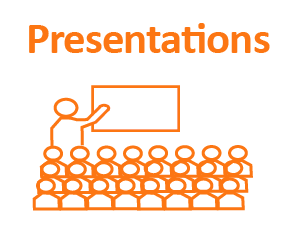
Attending a conference this year? Below are tips on speaking, designing slides, perfecting a project elevator speech, and formatting and designing a poster. Whether you are just an attendee or a keynote speaker, there should be something of interest to you.
Potential Conferences
CADRE compiles a list of STEM education-related conferences with links to the conference websites and submission deadlines for session proposals: Conferences for STEM Educators, Policymakers, and Researchers
Presentation Tips
There are a lot of tips on the Web for how to prepare an effective and engaging presentation. Here are six resources with advice:
- Applying Learning Principles to Presentation Delivery
The author, Jonathan Schwabish, is an economist by training and has a blog and a book on communicating your research better.
- A TED Speaker Coach Shares 11 Tips for Right Before You Go on Stage
Helpful tips that you don't hear elsewhere on preparing for a presentation.
- DO-IT Presentation Tips
Disabilities, Opportunities, Internetworking, and Technology gives detailed advice on how to give a quality presentation.
- Presentation Checklist: What to do Before and After Delivery
Before you give a presentation, you can use this checklist to make sure you haven’t missed anything.
- Presentation Tips
Communication consultant Garr Reynolds gives advice on preparing for your presentation, designing your slides, delivering your presentation, and more.
- Presentation Tips
Presentation Trainers Olivia Mitchell and Tony Burns give advice on planning the content of your presentation, creating effective PowerPoint slides, giving an effective presentation, overcoming the fear of public speaking, and managing the audience.
- Slidedeck Planning Sheet
Stephanie Evergreen, founder of EvergreenData, has created a tool for planning out your slidedeck before you even open up PowerPoint or Prezi.
- The Secret Structure of Great Talks [Video]
Presentation expert Nancy Duarte describes the structure that many great talks have in common.
- Top Tips for Effective Presentations
The 10 tips in this SkillsYouNeed article are based on published advice from expert presenters.
How to Create an Effective Elevator Speech
It's helpful to have an "elevator speech" prepared about your work for presentations, interviews, and casual conversation at conferences and with family and friends. The following all contain good (and different) advice on creating an elevator pitch. All these resources are from marketing companies, so you will need to adapt the information to your needs.
Tips on Creating a Poster
Keep in mind that your poster should quickly and efficiently communicate your research to viewers. The key to crafting a good poster is to focus as narrowly as possible on the central ideas you need to convey. You won't have room to explain relationships among ideas in any detail, so pick out what's central to your topic and concentrate on that narrow focus. Present the data and findings uncovered in your project, as well as the broader impact of your research. See poster examples from the 2023 DR K–12 PI meeting.
Suggested content for a research poster:
- Project title.
- Principal investigator's name and contact information.
- Brief summary of the project, including:
- What is the context of the work?
- What claims, questions, or hypotheses are examined in the work?
- What are your research design, data collection and analysis methods, and evaluation plan?
- What are your evidence-based results? What are your products?
- What are the implications of your findings?
- How is the project making an impact?
Formatting and Layout Tips
- Think about aspect ratio. This scientific poster tutorial gives advice on how to set up your PowerPoint document so that your poster size is correct when you go to print.
- Provide a title and your name in large text.
- Remember that viewers will typically expect information to flow from left to right and from top to bottom. If you want to use a different flow, be sure to give explicit signals on your poster.
- Use headings and subheadings to label your information. Keep these short and to the point since they function as an index.
- Use the same size margins on both graphics and text.
- Don't use glossy paper because reflections will make your content more difficult to read.
- Posters should be readable from a distance of 5 feet. Generally, the smallest readable type font at this distance is 20–25 pts. While a number of fonts can be used, the following are readable from a distance of 2' to 4': Arial and Bookman 20 pt. and Times New Roman 24 pt.
- The UC San Diego offers directions and tips for creating professional posters in PowerPoint.